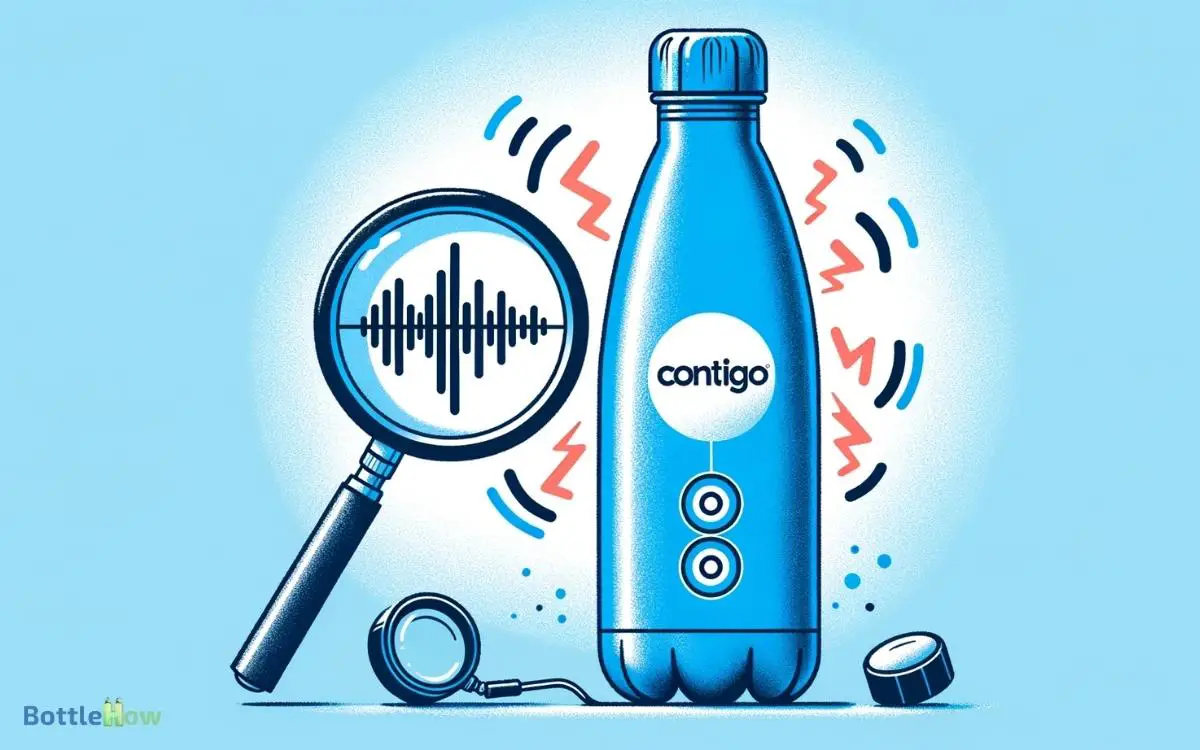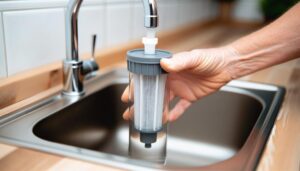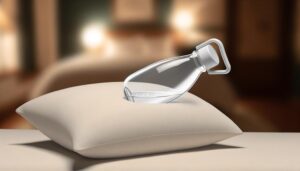Contigo Water Bottle Makes Noise: Find Out Here!
Your Contigo water bottle makes noise due to several reasons. Whistling happens when air escapes through a small opening, while gurgling is caused by liquid flowing through the bottle.
Squeaking might occur from friction between components like a worn rubber gasket or debris in the lid mechanism.
Key factors include air pressure build-up, temperature changes, and the bottle’s design. To minimize noise, make sure the lid is tight, inspect seals regularly, and avoid sudden temperature changes.
Learning more about these details could help you address and prevent these common issues.

Key Takeaways
Common Noises Observed
When using a Contigo water bottle, you might notice various noises such as whistling, gurgling, or squeaking, each indicating different underlying issues.
Whistling often occurs due to air escaping through a small opening, usually around the lid or spout.
Gurgling sounds are typically caused by the liquid flowing through the bottle, often exacerbated by rapid drinking or shaking.
Squeaking noises usually result from friction between the bottle’s components, like the lid and the body.
Each sound provides clues about the bottle’s functionality and potential maintenance needs. Understanding these noises helps you diagnose minor problems and maintain your bottle operates smoothly.
By paying attention to these auditory cues, you can upkeep your Contigo bottle more effectively.
Reasons for Hissing
You might notice a hissing sound from your Contigo water bottle due to air pressure build-up, which occurs when trapped air escapes through the lid.
Additionally, a malfunctioning seal can cause air or liquid to leak, resulting in a hissing noise. Temperature changes can also contribute by expanding or contracting the air inside, creating pressure differences that lead to hissing.
Air Pressure Build-Up
Several factors can contribute to the air pressure build-up inside a Contigo water bottle, resulting in the characteristic hissing noise.
To begin with, thermal expansion occurs when the liquid inside the bottle heats up, causing the air and liquid to expand.
Additionally, shaking the bottle vigorously can mix air and liquid, increasing internal pressure.
Another factor is filling the bottle to its maximum capacity leaves little room for air, which can lead to pressure changes.
Lastly, external temperature changes, such as moving from a cold to a warm environment, can cause the trapped air to expand.
Understanding these causes helps you manage the pressure and minimize the hissing, ensuring a better experience with your Contigo water bottle.
Seal Malfunction Issues
A common reason for the hissing noise in a Contigo water bottle is a malfunctioning seal that fails to maintain an airtight closure.
When the seal isn’t working correctly, air escapes, creating that distinctive hissing sound you’ve noticed. This issue can arise from several factors, including wear and tear, debris, or improper assembly.
| Cause | Description |
|---|---|
| Wear and Tear | Over time, seals degrade and lose effectiveness. |
| Debris | Dirt or particles can obstruct the seal, causing leaks. |
| Improper Assembly | Misalignment during assembly prevents a tight seal. |
To address this, inspect the bottle’s seal regularly. Clean any debris and make sure all parts are correctly aligned. This proactive approach helps maintain the bottle’s performance and eliminates unwanted noises.
Temperature Change Effects
Temperature fluctuations can cause the air inside a Contigo water bottle to expand or contract, leading to the hissing noise you hear.
When you fill your bottle with a cold or hot beverage, the temperature difference between the liquid and the surrounding air results in pressure changes.
Cold liquids can cause the air inside to contract, creating a partial vacuum, while hot liquids can cause expansion, increasing internal pressure.
This pressure imbalance seeks equilibrium, often escaping through the bottle’s seal, producing the hissing sound.
Understanding this phenomenon helps you realize that it’s a normal physical reaction, not a defect.
To minimize the noise, try filling your bottle with liquids closer to room temperature or make sure the seal is properly tightened.
Causes of Squeaking
When your Contigo water bottle starts to squeak, it can often be traced back to a few common causes that need attention.
First, check for any debris or dirt lodged in the lid’s mechanism. This can create friction, leading to squeaking noises.
Second, inspect the rubber gasket or seal; if it’s worn or damaged, it can cause improper sealing, resulting in noise.
Third, make sure that all parts are tightly assembled. Loose components can shift and produce squeaks during use.
Understanding Gurgling
When you hear your Contigo water bottle gurgling, it’s mainly due to airflow and water movement within the bottle.
The design of the bottle, including its spout and internal structure, greatly influences these sounds.
Analyzing these factors helps you understand why the gurgling occurs and how it might be mitigated.
Airflow and Water Movement
The gurgling sound in your Contigo water bottle is primarily caused by the interplay of airflow and water movement within the bottle’s design.
When you tilt the bottle to drink, water flows out while air needs to flow in to replace the displaced liquid.
This creates turbulence, leading to gurgling noises. Understanding this process can help you minimize the noise.
Key factors include:
- Air Ingress Points: Small openings allowing air to enter as water exits.
- Water Flow Rate: Faster flow rates increase turbulence and noise.
- Bottle Tilt Angle: The angle affects how smoothly water and air can exchange.
- Liquid Volume: A fuller bottle leaves less room for air to balance the pressure.
Bottle Design Factors
Examining the bottle’s design features, you’ll find that specific elements like the valve mechanism, spout shape, and internal straw system greatly affect the gurgling noise.
The valve mechanism regulates airflow and water release, and if it doesn’t function smoothly, it can create disruptive sounds.
The spout shape influences how air and water mix as you drink, potentially leading to gurgling if the design isn’t optimized.
Additionally, the internal straw system plays a critical role. If the straw isn’t properly aligned or has a faulty seal, air pockets can form, causing noise.
Understanding these design factors helps identify why your Contigo water bottle might be noisy and what adjustments could reduce or eliminate the gurgling.
Air Pressure Factors
Understanding air pressure factors can help pinpoint why your Contigo water bottle makes noise. When you drink, the air pressure inside the bottle changes, causing sounds.
Here’s what you need to know:
- Volume of Liquid: As the liquid level drops, more air enters, affecting pressure balance.
- Temperature Changes: Warm liquids expand air, while cold liquids contract it, leading to noise.
- Bottle Shape: Certain designs may amplify pressure changes, making noise more noticeable.
- Air Venting Mechanism: If the venting system isn’t working properly, trapped air can cause whistling or popping sounds.
Analyzing these factors objectively will help you understand the air pressure dynamics in your Contigo bottle, potentially mitigating unwanted noise.
Lid and Seal Issues
You’ve likely noticed that improper lid alignment can cause your Contigo water bottle to make unexpected noises.
When the seal isn’t tight, it compromises the bottle’s integrity, allowing air to escape and create pressure release sounds.
These issues not only affect the noise level but can also impact the bottle’s overall functionality.
Improper Lid Alignment
One common cause of noise in your Contigo water bottle is improper lid alignment. This can lead to seal issues and air leakage.
When the lid isn’t properly aligned, it can create gaps that allow air to escape, causing whistling or squeaking sounds.
To troubleshoot this issue, pay attention to the following:
- Lid Placement: Confirm the lid is seated correctly on the bottle.
- Threads: Check that the threads on both the lid and bottle are clean and undamaged.
- Tightening: Make sure the lid is securely tightened without cross-threading.
- Seal Inspection: Examine the rubber gasket for any signs of wear or misalignment.
Addressing these points can help you eliminate the noise and ensure a proper seal.
Loose Seal Integrity
Over time, the seal integrity of your Contigo water bottle can degrade, leading to noise issues and potential leaks.
When the seal becomes loose or compromised, it doesn’t form a tight barrier against the bottle’s lid. This can cause unusual sounds as air escapes or water shifts inside.
Inspect the rubber gasket for wear and tear; cracks or deformations indicate it needs replacing. Make sure the seal is properly seated in its groove. If you hear noises, try tightening the lid to see if it alleviates the problem.
Consistent maintenance helps prolong the seal’s effectiveness, reducing noise and preventing leaks. Addressing seal integrity promptly maintains your water bottle remains functional and quiet.
Pressure Release Sounds
When opening your Contigo water bottle, you might notice pressure release sounds that indicate issues with the lid or seal integrity. These sounds can be a result of trapped air or liquid pressure.
Addressing this problem requires a close look at several factors:
- Lid Fit: Guarantee the lid is screwed on properly and not cross-threaded.
- Seal Condition: Inspect the rubber seal for wear, cracks, or debris that could affect its performance.
- Temperature Changes: Rapid temperature shifts can cause pressure buildup inside the bottle.
- Overfilling: Avoid filling the bottle to the brim, as this can create excess pressure.
Understanding these elements helps you identify and resolve the root causes, ensuring your Contigo water bottle functions quietly and efficiently.
Water Bottle Material
The material of your Contigo water bottle plays a significant role in the noise it produces. Stainless steel and plastic are the primary materials used in these bottles.
Stainless steel is more rigid, leading to louder noises when the bottle is dropped or impacted. Plastic, on the other hand, is more flexible and tends to produce softer sounds.
Here’s a comparison:
| Material | Noise Characteristics |
|---|---|
| Stainless Steel | Loud, sharp sounds upon impact or pressure |
| Plastic | Softer, more muffled noises |
Additionally, the thickness of the material can also affect the noise level. Thicker walls generally produce deeper, less sharp sounds.
Understanding these properties helps you choose a bottle that suits your preference for noise levels.
Proper Cleaning Techniques
Maintaining your Contigo water bottle clean not only guarantees a fresh taste but also minimizes any unwanted noises that might arise from residue build-up or improper maintenance.
To achieve this, it’s crucial to follow specific cleaning techniques:
- Disassemble Completely: Remove the lid, straw, and any detachable parts to make sure every component gets cleaned thoroughly.
- Use Warm, Soapy Water: Gently scrub all parts with a brush, focusing on crevices where residue might accumulate.
- Rinse Thoroughly: Make certain all soap is rinsed off to prevent any build-up that could cause noise or affect taste.
- Air Dry: Let all parts dry completely before reassembling to avoid moisture-related issues.
These steps help maintain your bottle’s functionality and prevent any noise-related problems.
Using the Straw Correctly
To guarantee your Contigo water bottle functions at its best and remains noise-free, mastering the correct use of the straw is essential. Ensuring the straw is securely attached and properly aligned can prevent leaks and suction issues. If the straw is misaligned, you may experience Contigo bottle drinking difficulty, making it harder to get a steady flow of water. Regular cleaning and maintenance can also help keep the straw clear of blockages, ensuring a smooth and quiet drinking experience.
Begin by ensuring the straw is securely attached to the lid; a loose connection can cause air leaks, leading to noise. When inserting the straw, push it firmly until you hear a click, indicating it’s properly seated.
Additionally, check that the straw isn’t bent or damaged, as this can obstruct water flow, creating gurgling sounds.
While drinking, maintain a steady suction; excessive force can introduce air, resulting in noise.
Preventing Noise Tips
For a noise-free experience with your Contigo water bottle, start by confirming all components are correctly assembled and securely fastened. Misalignment can cause air leaks, leading to unwanted sounds.
Additionally, consider these practical tips:
- Check the Seal: Verify that the rubber gasket inside the lid is intact and properly seated to prevent air from escaping.
- Adjust Straw Placement: Make sure the straw isn’t too tight or too loose, as improper placement can cause noise during use.
- Avoid Overfilling: Leave some space at the top of the bottle to avoid pressure build-up, which can create noise.
- Clean Regularly: Residue buildup can affect the seal and moving parts, leading to noise, so clean your bottle thoroughly.
Implementing these steps should help minimize noise.
User Experiences
Many users report that despite following preventive measures, their Contigo water bottles still occasionally produce noise, indicating potential design limitations or variances in individual usage patterns.
Some users notice a whistling sound when they drink, while others experience a popping noise as they open the lid.
These sounds can be attributed to air pressure changes or the movement of internal components.
Users have noted that the noise level varies depending on the bottle’s fill level and the temperature of the liquid inside.
Additionally, some users find the noise more pronounced after repeated use, suggesting that wear and tear might exacerbate the issue.
Such experiences highlight the need for a closer examination of the product’s design and material integrity.
Expert Recommendations
Experts suggest thoroughly inspecting the bottle’s seals and components to make sure they’re properly aligned and free from debris, as this can mitigate the noise issue. A misaligned seal or a small piece of debris can cause the bottle to make unexpected sounds.
To help you address this problem, experts recommend the following steps:
- Disassemble and Clean: Take apart the bottle, and clean each component thoroughly.
- Check Seal Integrity: Inspect the seals for any damage or wear and replace if necessary.
- Reassemble Carefully: Ensure all parts are reassembled correctly and securely.
- Test Functionality: Fill the bottle and test it to confirm that the noise issue is resolved.
Alternative Quiet Bottles
If you’ve exhausted all troubleshooting steps and the noise persists, you might consider exploring alternative quiet bottles that don’t suffer from the same issues.
Several brands offer reliable, silent water bottles designed to meet your hydration needs without unwanted sounds. Analyzing your options can help you find a bottle that fits your lifestyle and preferences.
| Brand | Features | Price Range |
|---|---|---|
| Hydro Flask | Insulated, durable, quiet | $30-$50 |
| S’well | Sleek design, no noise | $25-$45 |
| Nalgene | Lightweight, silent | $10-$20 |
| Klean Kanteen | Eco-friendly, quiet cap | $20-$40 |
| CamelBak | Spill-proof, silent valve | $15-$30 |
Each brand offers unique benefits, ensuring you can enjoy a noise-free hydration experience tailored to your needs.
Conclusion
To sum up, your Contigo water bottle’s noises—hissing, squeaking, and gurgling—often stem from air pressure changes and liquid movement. Understanding these factors helps you mitigate the sounds.
While some users report success with simple fixes like proper sealing, the theory that design flaws are the root cause is worth exploring further. For a quieter experience, consider expert-recommended alternatives.
Each bottle’s performance varies, so your experience might differ. Investigate and choose wisely for your needs.





